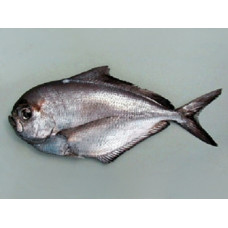Latin name
Brama brama
Other names
Ray's bream
Identification
The body is large, strongly compressed at the sides. Forehead strongly convex. Snout blunt, mouth terminal and oblique. Eyes large, oval in shape, horizontal diameter of eye less than length of snout. Anterior nostrils elliptical, directed forward. Rear nostrils slit-shaped. The jaws have small conical teeth in several rows; there are no canine teeth. The teeth on the palate are small. Pharyngeal teeth are well developed. The first gill arch has 15 to 18 gill stamens, of which there are 4-7 gill stamens on the upper half and 8-12 on the lower half. The tail peduncle is short and narrow. There are 70-90 scales on the lateral line. The vertebrae are 41-45.
Features of fish fins
Dorsal fin with 35-38 soft rays beginning above the bases of the pectoral fins. The rays are much longer in the anterior part of the fin than in the posterior part. The anal fin has 29-32 soft rays, the rays being longer in the anterior part. The dorsal and anal fins are covered with scales, which do not form a groove at their base into which the fins could fold. Caudal fin forked. Pectoral fins are long with 20-23 soft rays, set low on the body. The pelvic fins are located below the bases of the pectoral fins.
Fish colouring
The body is dark brown with a silvery tinge to the sides. The dorsal and upper edges of the fins are blackish. The pectoral and ventral fins are yellowish.
Distribution
Widespread in temperate, subtropical and tropical waters of all oceans. Widespread in the Atlantic, Indian and Pacific Oceans from tropical to warm temperate regions. Western Atlantic: from Nova Scotia to Belize, the Antilles and northern South America, including Bermuda and the Gulf of Mexico. Eastern Atlantic: from Iceland and central Norway to Angola and southern Africa, including the Mediterranean. In the Indian and Pacific Oceans, found south of 30°S.
Habitat
Marine pelagic oceanodromous fish. Their distribution is limited to waters with temperatures not lower than 10° C and not higher than 24° C. They live at depths from 0 to 1000 m.
Size
Maximum body length 100 cm, usually up to 40 cm. Body weight up to 6 kg.
Behavior
They make diurnal vertical migrations, moving to shallower depths at night. Extended seasonal migrations are associated with changes in water temperature.
Food and feeding habits
They feed on a variety of food items, i.e. they are characterized by opportunistic feeding behavior. Diet composition varies according to habitat area, season, etc. The diet includes fish, amphipods, euphausiids, crustaceans, cephalopods, krill. Of the fish, Myctophidae, Pleuronectidae, Ammodytes, Merluccius, Gadidae, etc. have been found in stomachs.
Reproduction
In the Mediterranean they spawn in August-September, in the Eastern Atlantic a little later, at temperatures not lower than 19.5°C and not higher than 23.8°C. The eggs are spherical and 1.5-1.6 mm in diameter. The eggs are spherical with a diameter of 1.5-1.6 mm. The chorion is smooth. A fat droplet is oval in shape and measures 0.4x0.32 mm. The body length of the larvae immediately after hatching is 3-4 mm. The scales are fully developed at a body length of about 13 mm. Eggs and larvae are pelagic.
Fishing
Valuable commercial fish. The flesh tastes similar to tuna.
| Classification | |
| Phylum | Chordata |
| Class | Actinopterygii |
| Squad | Perciformes |
| Family | Bramidae |
| Genus | Brama |
| Species | B. brama |
| Features | |
| Conservation status | Least Concern |
| Habitat | Pelagic |
| Life span, years | No information |
| Maximum body weight, kg | 6 |
| Maximum length, cm | 100 |
| Sailing speed, m/s | No information |
| Threat to people | Edible |
| Way of eating | Predator |
Atlantic pomfret
Tags: atlantic pomfret

